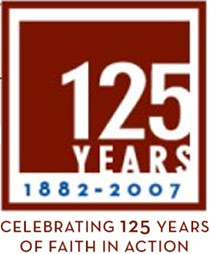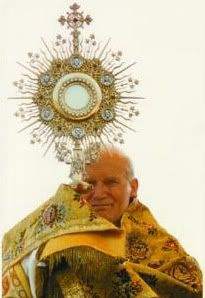Sacred Vessels, Part 4: Paten

Chalice
Pyx
Ciborium
The paten is the simplest of the sacred vessels, and like the chalice, has maintained a striking continuity in form throughout history.
Traditionally, the paten was used only on the altar. The priest placed the bread on the paten during the offertory and used it to hold the consecrated host following the Fraction. Larger patens equipped with handles were used (and may still occassionally be seen in places) to keep bits of the host from falling to the ground during the distribution of the Eucharist. Since Vatican II there has been a multiplication of patens within the mass, for they are used by the extraordinary ministers to hold the hosts they are distributing. Only the one main paten, however, is used on the altar by the priest.
The word itself comes from the Latin patina or patena, which itself is thought to be an imitation of the Greek patane. The paten has been, since the earliest times of the Church, a flat or slightly concave open dish in the manner of a small plate. In the first centuries of the Church patens were used in the service of the altar, and seemingly were used to distribute the Blessed Sacrament among the people and to collect the fragments afterwards (the use of leavened bread in those days multiplied the existence of fragments, as did the practice that existed in some places of passing the paten among the congregation who received from it themselves). Some of these patens, because of the nature of their use, weighed twenty or thirty pounds and were quite large. They were constructed of glass, wood, copper, as well as gold and silver.
By the 9th century the use and form of the paten had changed to more closely resemble what we are today familiar with. The priest used the paten on the altar to contain the particles that would fall during his own handling of the sacred species. As the "pass the plate" method of reception of the Eucharist had disappeared, there was no longer any reason for the very large patens of the first and second centuries. Also, our patens today are oftentimes more bowl-like than those used prior to Vatican II. This, of course, reflects the alteration in their use made necessary by the revisions to the missal. A very flat, sharp edged paten is well suited to holding the consecrated host on the altar and scraping up dropped particles. It is ill suited, however, to containing the numerous small hosts to be distributed to the faithful. Furthermore, the reinstitution of the presentation of the gifts following Vatican II has in some places given rise to the use of very large, deep patens for the purpose of containing the small hosts that are brought forward. This large paten is not used to distribute the Blessed Sacrament, as it would be unwieldy for the minister to hold.
Like the inside of a chalice, the concave (or "up") side of a paten must be gilt with silver or gold. In the early Church they were heavily decorated, but this practice was abolished and strict regulations instituted regarding the ornamentation of the paten. For many years it was not permissable for any ornament to be present on the concave side except on the rim. Patens, like chalices, must be consecrated prior to use. A paten loses its consecration if it is broken to such an extent that it is no longer fit for its purpose (eg, if it has cracks large enough for particles of the Blessed Sacrament to fall through), or if it becomes so battered so that its use would be unbecoming. The act of regilding formerly resulted in loss of consecration, but this is no longer the case. Also unlike preconcilar days, lay persons may lawfully touch the paten. Like other sacred vessels, it is no longer permissable to make a paten out of glass, earthware, or other base or easily breakable material, or to construct it in a manner bereft of artistic merit.
File Under: Sacred_Vessels








1 Comments:
Another beautiful post on your series. I remember you added your writings on the Chalice to the Catholic Wikipedia Online.
May I add your other parts of your series to the Catholic Wikipedia? I ask because we need article on these topics, and your posts have everything there one would need.
Great job. And thanks
Post a Comment
<< Home